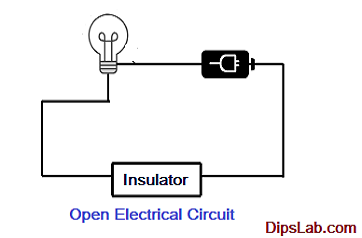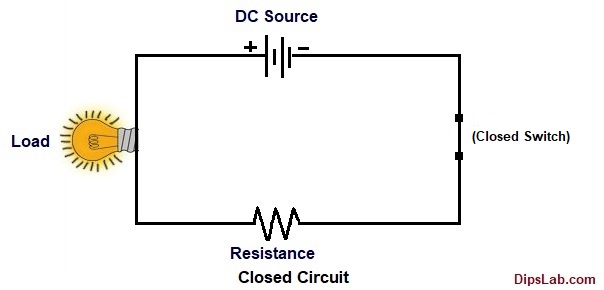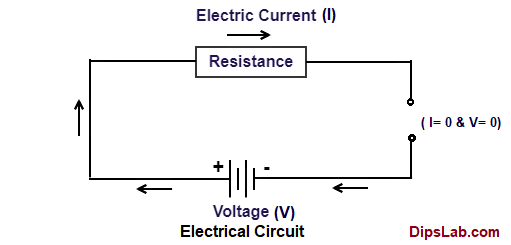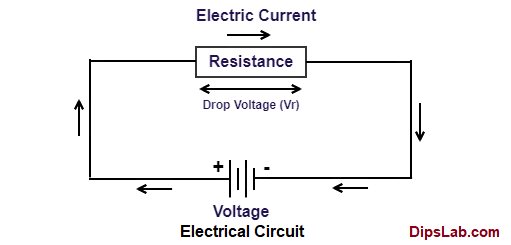
In this post, we are going to learn about the difference between the open and the close circuit.
Firstly, I start from basic terms,
Table of Contents
What is Open Circuit?
In Open Circuit, the electric current (charged particles) does not flow from an active energy source to the connected load or other components due to the incomplete path.
If any components disconnect or break from the circuit, this circuit works as the open circuit. Sometimes, the open circuit shows like OFF condition or fault condition.
Example of Open Circuit:
Suppose, we have connected the DC supply battery with the connected bulb as load, resistance, and switch.
When the switch is open, the electric current does not flow from the source (battery) to the desired load (light).

Thus, this circuit does not conduct the electricity and zero potential difference occurs between two terminals of the open switch due to the incomplete path.
In another case, when we connect insulators or insulating devices in an electric circuit, electricity does not flow even though the circuit path is complete.
Given below is the diagram with connecting source, load, and insulator.

Due to the insulator, the current does not pass in a circuit, and light does not glow.
It means that, sometimes, an insulator works as an open circuit.
What is Closed Circuit?
In a closed circuit, the electric current (charged particles) flows from an active energy source to the connected load or other components due to the closed-loop path.
For the closed circuit, we require
- conducting materials or conductor (like copper) path
- the active voltage source device (like a battery)
- complete path or circuit to flow the electric current
Example of Closed Circuit:
Suppose, the DC voltage supply battery is connected with the light (like load) and closed switch. Due to the closed switch, the circuit makes the complete path to the flow electric current.

From the above diagram, you can see the bulb is glowing in the closed circuit.
Difference between Open Circuit and Close Circuit
In tabular form, I am comparing the basic points- open circuit vs closed circuit.
| # | Content | Open Circuit | Closed Circuit |
| 01 | Basic | An open circuit makes an incomplete path to flow the active energy from the source to the load. | A closed circuit makes a complete path to flow the active energy from the source to the load. |
| 02 | Electric Current | In an electrical open circuit, the current does not flow. | In an electric closed circuit, current flow from the positive charge to the negative charge particles. |
| 03 | Symbol (Basic) | It is represented by ‘( )’ in an electric circuit. | It is represented by ‘( . )‘ in an electric circuit. |
| 04 | Potential Difference | In an electric circuit, the potential difference does not occur between the two terminals of an open circuit. | In an electric circuit, the potential difference occurs between the two terminals of the closed circuit. |
| 05 | Nature | The open circuit can’t conduct electricity. | The closed circuit conducts electricity with the help of connected active elements (like a cell, battery, etc). |
| 06 | State | This circuit works as an ‘Off’ state position. | This circuit works continuously ‘On’ state position. |
07. Open and Closed Circuit Diagram
Open Circuit: In an electric open circuit, no electrical connection occurs in between the source and load.

If any sides of the source or other components disconnect in an electric circuit, the current will not flow. That’s why the load will not be activated.
Closed Circuit: In a closed circuit, closed-loop path occurs with the connected source and the load.

For the electrical and electronic circuits working (open circuit and closed circuit), we need a switch to make (On) and break (Off) the circuit.
In a power system, the circuit breaker and fuse perform the same switching (make and break the circuit) role by manually and automatically at fault conditions.
This is the explanation of the open and closed circuit with the block diagram.
If you have any quires, you can freely comment given below.
Related read more differences:
- Alternating current vs Direct current
- Anode vs Cathode
- Conductor vs Insulator
- Resistance vs Reactance
- Capacitor vs Battery
- Series circuit vs Parallel circuit
- Electrical circuit vs Magnetic circuit
- Single-phase vs Three-phase AC systems
- Analog multimeter vs Digital multimeter
Thanks for Reading!
Hi Dipali,
It’s a very nice article. Could you please explain your 4th point? What do you mean by the potential difference between the two different terminals?
Thanks for the comment.
I have already explained the potential difference concept in an open circuit example. You can read more about the earlier tutorial on Potential Difference and voltage.
When electricity flows from an energy source to the load and back to the source of the circuit. Closed circuit has complet path for current flow.
Open circuit doesn’t.
Thanks, for the explanation. 🙂
Open circuit is no work done. But for closed circuit there is work done.
Thanks, I will add this point.
Open circuit means No load and close circuit means loading. Simple.
Thanks 🙂
Logical on/off of mind blocked means inner engineering meditation mode and open mind means outward world yoga exercise.
An open circuit is one where the continuity has been broken by an interruption in the path for current to flow. A closed-circuit is one that is complete, with good continuity throughout.
A device designed to open or close a circuit under controlled conditions is called a switch.
Thanks, for defined and explained the comparision open and closed circuit.
Welcome
I analysis and I look at the side is fantastic.
Thanks, Kshitij 🙂
Thank you so much for your kind words! I’m really glad to hear that the examples helped clarify the differences between open and closed circuits for you.